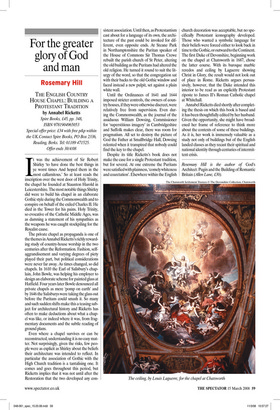For the greater glory of God and man
Rosemary Hill
THE ENGLISH COUNTRY HOUSE CHAPEL: BUILDING A PROTESTANT TRADITION by Annabel Ricketts Spire Books, £45, pp. 348, ISBN 9781904965053 Special offer price: £34 with free p&p within the UK.Contact Spire Books, PO Box 2336, Reading, Berks. Tel: 01189 471525. Offer ends 30/4/08 It was the achievement of Sir Robert Shirley ‘to have done the best things in ye worst times And hoped them in the most callamitous.’ So at least reads the inscription over the west door of Holy Trinity, the chapel he founded at Staunton Harold in Leicestershire. The most notable things Shirley did were to build his chapel in an elaborate Gothic style during the Commonwealth and to conspire on behalf of the exiled Charles II. He died in the Tower for his pains. Holy Trinity, so evocative of the Catholic Middle Ages, was as damning a statement of his sympathies as the weapons he was caught stockpiling for the Royalist cause.
The private chapel as propaganda is one of the themes in Annabel Ricketts’s richly rewarding study of country-house worship in the two centuries after the Reformation. Fashion, selfaggrandisement and varying degrees of piety played their part, but political considerations were never far away. As times changed, so did chapels. In 1610 the Earl of Salisbury’s chaplain, John Bowle, was helping his employer to design an elaborate scheme for painted glass at Hatfield. Four years later Bowle denounced all private chapels as mere ‘pomp on earth’ and by 1646 the Salisburys were taking the glass out before the Puritans could smash it. So many and such sudden shifts make this a teasing subject for architectural history and Ricketts has often to make deductions about what a chapel was like, or indeed where it was, from fragmentary documents and the subtle reading of ground plans.
Even where a chapel survives or can be reconstructed, understanding it is no easy matter. Not surprisingly, given the risks, few people were as explicit as Shirley about the beliefs their architecture was intended to reflect. In particular the association of Gothic with the High Church tradition is a tantalising one. It comes and goes throughout this period, but Ricketts implies that it was not until after the Restoration that the two developed any con sistent association. Until then, as Protestantism cast about for a language of its own, the architecture of the past could be invoked for different, even opposite ends. At Steane Park in Northamptonshire the Puritan speaker of the House of Commons Sir Thomas Crewe rebuilt the parish church of St Peter, altering the old building as the Puritans had altered the old religion. He turned it round to suit the liturgy of the word, so that the congregation sat with their backs to the old Gothic window and faced instead a new pulpit, set against a plain white wall.
Until the Ordinances of 1641 and 1644 imposed stricter controls, the owners of country houses, if they were otherwise discreet, were relatively free from supervision. Even during the Commonwealth, as the journal of the assiduous William Dowsing, Commissioner for ‘superstitious imagery’ in Cambridgeshire and Suffolk makes clear, there was room for pragmatism. All set to destroy the picture of God the Father at Smallbridge Hall, Dowsing relented when it transpired that nobody could find the key to the chapel.
Despite its title Ricketts’s book does not make the case for a single Protestant tradition, but for several. At one extreme the Puritans were satisfied with plainness, ‘comely whiteness and coarctation’. Elsewhere within the English church decoration was acceptable, but no specifically Protestant iconography developed. Those who wanted a symbolic language for their beliefs were forced either to look back in time to the Gothic, or outward to the Continent. The first Duke of Devonshire, beginning work on the chapel at Chatsworth in 1687, chose the latter course. With its baroque marble reredos and ceiling by Laguerre showing Christ in Glory, the result would not look out of place in Rome. Ricketts argues persuasively, however, that the Duke intended this interior to be read as an explicitly Protestant riposte to James II’s Roman Catholic chapel at Whitehall.
Annabel Ricketts died shortly after completing the thesis on which this book is based and it has been thoughtfully edited by her husband. Given the opportunity, she might have broadened her frame of reference to think more about the contexts of some of these buildings. As it is, her work is immensely valuable as a study not only of buildings but of the English landed classes as they recast their spiritual and national identity through centuries of intermittent crisis.


























































































 Previous page
Previous page